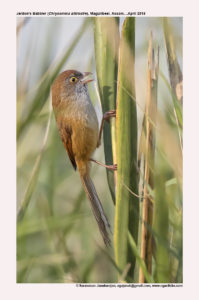
Jerdon’s Babbler Chrysomma altirostre
Etymology:
- Chrysomma : Greek word khrusos gold; omma eye.
- Altirostre : Latin word Alti – High, Rostrum- Beak
Vernacular Names: Urdu: Mullala, Ass: Tiri-sorai
Distribution in India: Resident of North East of India.
Description: Size of 17 cm. It is a small, stubby-billed babbler with long graduated tail, plumage rich brown above, grey and buff below. The nominate race has forehead blackish with jagged ashy margins; crown is dull chestnut-brown, shading slightly paler on upperparts, upperwing and tail. The lores and supercilium are hoary grey, ear-coverts are brown, chin, submoustachial area, throat and breast are pale grey, shading to buffy on rest of underparts. The iris is brown, orbital skin is pale greenish-yellow; bill is pale brown, lower mandible is paler; legs are pale fleshy or orange-brown. Both the sexes are similar. The juvenile is slightly paler above, more rufescent below, with dusky bill and buffy lores.
Habitat: It is found in extensive tall riverine grassland of various types, denser, uncut stands of reeds and bulrushes.
Food Habits: It eats grasshoppers, beetles, ants and small seeds. It is found in pairs or in small parties. It is highly skulking. It forages by perching almost perpendicular to vertical stems, grasping base of leaf and vigorously ripping downwards, apparently to expose invertebrate prey.
Breeding Habits: They breed in Sept in Pakistan, and Apr and Jul in India. The nest is built by both partners. The nest is a neat frail cup, shallow or deep, made of dried reed leaves or tightly drawn grasses, sometimes plastered with cobwebs, lined with vegetable fibre and down, and woven around several vertical stems in clump of vegetation. They lay a clutch of 2–3 eggs. Both parents provision the nestlings.